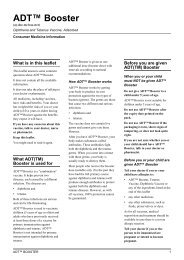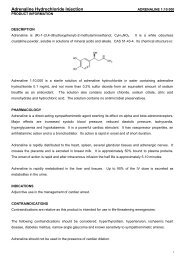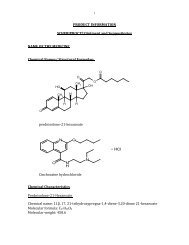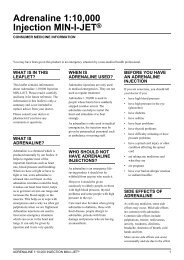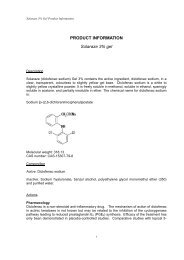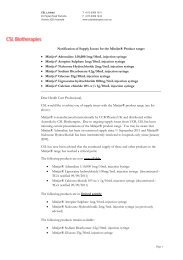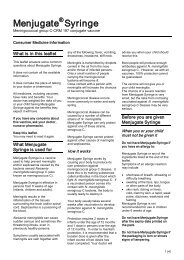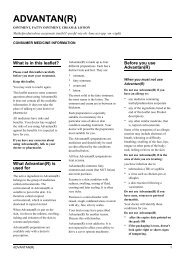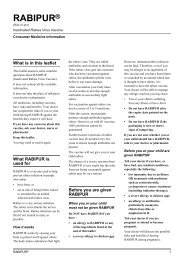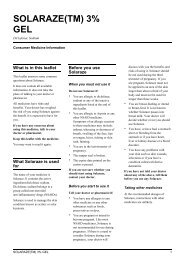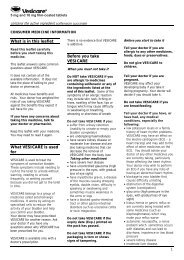PRODUCT INFORMATION – ADVANTAN OINTMENT FATTY OINTMENT CREAM & LOTION
PRODUCT INFORMATION â ADVANTAN OINTMENT ... - bioCSL
PRODUCT INFORMATION â ADVANTAN OINTMENT ... - bioCSL
- No tags were found...
Create successful ePaper yourself
Turn your PDF publications into a flip-book with our unique Google optimized e-Paper software.
<strong>PRODUCT</strong> <strong>INFORMATION</strong> <strong>–</strong><br />
<strong>ADVANTAN</strong> ® <strong>OINTMENT</strong>, <strong>FATTY</strong><br />
<strong>OINTMENT</strong>,<br />
<strong>CREAM</strong> & <strong>LOTION</strong><br />
NAME OF THE DRUG<br />
The chemical name is 21-acetoxy-11β-hydroxy-6α-methyl-17-propionyloxy-1, 4-<br />
pregnadiene-3, 20-dione.<br />
The chemical structure is<br />
O<br />
HO<br />
O<br />
CH 3<br />
O<br />
O<br />
CH 3<br />
H<br />
O<br />
H<br />
H<br />
O<br />
CH 3<br />
The CAS registry number is 86401-95-8. The molecular formula is C 27 H 36 O 7 . The<br />
molecular weight is 472.58.<br />
DESCRIPTION<br />
The active ingredient of the Advantan ® formulations is the synthetic corticosteroid<br />
methylprednisolone aceponate (MPA), which is a white crystalline powder.<br />
Methylprednisolone aceponate is soluble in methylene chloride, acetone and ethyl<br />
acetate and is sparingly soluble in hexane and ether.<br />
Advantan ® ointment is a water-in-oil emulsion containing 30% purified water. It also<br />
contains white soft paraffin, heavy liquid paraffin, white beeswax and Dehymuls E.<br />
Advantan ® fatty ointment is a monophasic ointment with 96.9% hydrocarbons (white<br />
soft paraffin, heavy liquid paraffin, microcrystalline wax) and hydrogenated castor oil.<br />
Advantan ® cream is an oil-in-water emulsion containing about 60% purified water. It<br />
also contains decyl oleate, glyceryl monostearate, cetostearyl alcohol, hard fat, Softisan<br />
378, PEG-40 stearate, glyceryl 85%, butylated hydroxytoluene, benzyl alcohol, and<br />
disodium edetate.<br />
Advantan ® lotion is an oil-in-water emulsion containing 68% purified water. It also<br />
contains medium chain triglycerides, caprylic/capric/stearic triglycerides, steareth-2,<br />
steareth-21, benzyl alcohol, disodium edetate and glycerol.
PHARMACOLOGY<br />
Pharmacodynamics<br />
After topical application, Advantan ® (methylprednisolone aceponate) has antiinflammatory,<br />
anti-pruritic and vasoconstrictive actions.<br />
As for all other glucocorticoids, the mechanism of action of methylprednisolone<br />
aceponate is not completely understood. It is known that methylprednisolone<br />
aceponate binds to the intracellular glucocorticoid receptor as does the principal<br />
metabolite 6α-methylprednisolone-17-propionate, which is formed by cleavage in the<br />
skin. The steroid-receptor complex binds to certain regions of DNA, inducing antiinflammatory,<br />
anti-pruritic and vasoconstrictive effects.<br />
Binding of methylprednisolone aceponate or its metabolites to the steroid receptor<br />
results in the induction of lipomodulin synthesis. Lipomodulin, a protein secondary<br />
messenger (also known as lipocortin 1 and macrocortin) inhibits release of arachidonic<br />
acid, which in turn inhibits the formation of inflammatory mediators, such as<br />
prostaglandins and leukotrienes.<br />
The immunosuppressive action of glucocorticoids can be explained in part by their<br />
inhibitory effects on chemotaxis (inhibition of leukotriene synthesis). Glucocorticoids<br />
also have anti-mitotic activity, which is not well understood.<br />
The vasoconstrictive activity of glucocorticoids results from the inhibition of<br />
prostaglandin synthesis. Prostaglandins have vasodilatory actions. Glucocorticoids<br />
also potentiate the vasoconstrictive effect of adrenaline.<br />
Please note that the base formulations of the various Advantan ® presentations influence<br />
the therapeutic effects (see PRESENTATION).<br />
Pharmacokinetics<br />
Methylprednisolone aceponate is bioavailable from all formulations (cream, ointment,<br />
fatty ointment and lotion). When applied topically the concentration of<br />
methylprednisolone aceponate is highest in the outer layer of the epidermis (stratum<br />
corneum) and decreases progressively in the deeper strata.<br />
Methylprednisolone aceponate is hydrolysed in the epidermis and dermis to the<br />
principal metabolite, 6α-methylprednisolone-17-propionate. This metabolite binds to the<br />
intracellular glucocorticoid receptor with higher affinity than methylprednisolone<br />
aceponate. The binding of 6α-methylprednisolone-17-propionate to the receptor is an<br />
indicator of “bioactivation” in the skin.<br />
Percutaneous absorption:<br />
The degree of percutaneous absorption of methylprednisolone aceponate varies<br />
according to the state of the skin (intact/inflamed/damaged), the formulation<br />
(ointment/fatty ointment/cream/lotion) and the conditions of application (ope/occlusion).<br />
Studies using the ointment, fatty ointment and cream formulations in juvenile and adult<br />
patients with neurodermatitis and psoriasis have shown that the percutaneous
absorption on open application was slightly (≤2.5%) greater than the percutaneous<br />
absorption in volunteers with normal skin (0.2 <strong>–</strong> 1.5%). Occlusive dressing increased<br />
percutaneous absorption. When the superficial horny layer is removed before<br />
application of methylprednisolone aceponate, the corticoid levels in the skin are about<br />
three times higher than after application to intact skin.<br />
Skin was artificially damaged to investigate the percutaneous absorption of<br />
methylprednisolone aceponate from the lotion formulation. Intact skin was compared<br />
with both artificially inflamed (UV-B erythema) and artificially damaged (removal of<br />
horny layer) skin. The absorption through artificially inflamed skin was very low (0.27%)<br />
and was only marginally higher than the absorption through intact skin (0.17%). The<br />
percutaneous absorption of methylprednisolone aceponate through artificially damaged<br />
skin resulted in higher levels of corticoid in the skin (15%).<br />
Systemic absorption:<br />
After absorption into the systemic circulation, the primary hydrolysis product of<br />
methylprednisolone aceponate, 6α-methylprednisolone-17-propionate, is rapidly<br />
conjugated with glucuronic acid, and as a result, inactivated.<br />
The principal metabolites of methylprednisolone aceponate are eliminated primarily via<br />
the kidneys. The half-life is about 16 hours. Following intravenous administration,<br />
excretion via the urine and faeces was complete within 7 days. There is no<br />
accumulation of methylprednisolone aceponate or metabolites in the body.<br />
The systemic effects of methylprednisolone aceponate are minimal in both man and<br />
animals following application of a topically effective dose. After treatment of large areas<br />
in patients with skin disorders, the plasma cortisol values remain within the normal<br />
range; circadian cortisol rhythm is maintained and no reduction of cortisol has been<br />
ascertained in 24-hour urine.<br />
CLINICAL TRIALS<br />
Topical treatment of eczema in adults using methylprednisolone aceponate<br />
1mg/g lotion<br />
The effectiveness of Advantan ® lotion and other topical corticosteroids was measured<br />
by standardised clinical assessment of signs and symptoms from which a total (sum)<br />
score for comparison was derived. The observed difference (up to 20%) in comparative<br />
sum scores is considered within norms for observer variability, and not clinically<br />
meaningful. In clinical studies, where active treatment arms were compared, the ratio of<br />
effectiveness of the two treatments did not vary by more than 20%. The statistically<br />
significant equivalence band for 95% CI of ratios was 0.8-1.25.<br />
One double-blind, multicentre, randomised, vehicle-controlled study assessed the<br />
efficacy and safety of methylprednisolone aceponate (MPA) lotion 1mg/g applied<br />
topically twice daily in patients with eczema. The study was 14 days duration. The<br />
primary efficacy endpoint was the total score of selected objective and subjective<br />
symptoms of eczema (erythema, oedema, vesicles, papules, weeping and itching). The<br />
mean total score at the end of treatment was statistically significant (p=0.001, onesided)<br />
favouring MPA.
Table 1: Twice-daily administration of MPA 1mg/g lotion in adults<br />
Treatment administered: MPA lotion (n=99) Vehicle (n=48)<br />
Results:<br />
Total score (mean±sd)<br />
14.5±3.9<br />
Baseline:<br />
End:<br />
8.2±3.7<br />
P=0.001 (one-sided)<br />
14.6±4.2<br />
10.0±5.4<br />
One double-blind, multicentre, randomised, vehicle-controlled study of 14 days duration<br />
assessed the efficacy and safety of MPA lotion 1mg/g applied twice daily versus<br />
amcinonide 0.1% lotion twice daily in patients with eczema. The primary efficacy<br />
endpoint was the total score of selected objective and subjective symptoms of eczema<br />
(erythema, oedema, vesicles, papules, weeping and itching). The mean total score at<br />
the end of treatment was statistically significant (p=0.036, one-sided) favouring MPA<br />
over placebo; MPA lotion was equivalent to amcinonide lotion (95% CI: 0.94, 1.11).<br />
Table 2: Twice-daily administration of MPA 1mg/g lotion versus amcinonide lotion 0.1%<br />
in adults<br />
Treatment administered: MPA lotion<br />
(n=85)<br />
Results:<br />
Total score (mean±sd)<br />
Baseline:<br />
End:<br />
14.8±3.3<br />
7.5±2.4<br />
Amcinonide lotion<br />
(n=81)<br />
Vehicle<br />
(n=51)<br />
15.0±3.5<br />
7.8±2.8<br />
MPA vs vehicle p=0.036 (one-sided)<br />
MPA vs amcinonide: 95% CI: 0.94, 1.11<br />
15.7±3.7<br />
9.1±4.3<br />
One double-blind, multicentre, randomised study of 14 days duration assessed the<br />
efficacy and safety of MPA lotion 1 mg/g vs betamethasone 17-valerate 0.1% lotion in<br />
patients with eczema. MPA lotion was applied either once or twice daily, whereas<br />
betamethasone was applied twice daily. The primary efficacy endpoint was total score<br />
of selected objective and subjective symptoms of eczema (erythema, oedema, vesicles,<br />
papules, weeping and itching). At the end of treatment, MPA lotion was equivalent to<br />
betamethasone lotion.<br />
Table 3: Administration of MPA 1 mg/g lotion versus betamethasone in adults<br />
Treatment administered: MPA lotion<br />
(OD) (n=146)<br />
Results:<br />
Total score (mean±sd)<br />
16.1±3.9<br />
Baseline:<br />
8.1±3.0<br />
End:<br />
OD <strong>–</strong> once daily; BD <strong>–</strong> twice daily<br />
MPA lotion<br />
(BD) (n=94)<br />
15.6±3.9<br />
7.6±2.3<br />
Betamethasone lotion<br />
(BD) (n=95)<br />
15.7±4.1<br />
7.0±1.8<br />
MPA OD vs MPA BD: 95% CI: 0.94, 1.10<br />
MPA OD va betamethasone: 95% CI: 1.02, 1.20<br />
MPA BD vs metamethasone: 95% CI: 1.00, 1.20
One double-blind, multicentre, randomised study assessed the efficacy and safety of<br />
MPA lotion 1 mg/g versus amcinonide 0.1% lotion in patients with eczema. MPA lotion<br />
was applied either once or twice daily, whereas amcinonide was applied twice daily.<br />
The study was of 14 days duration. The primary efficacy endpoint was the total score of<br />
selected objective and subjective symptoms of eczema (erythema, oedema, vesicles,<br />
papules, weeping and itching). At the end of treatment, MPA lotion was equivalent to<br />
amcinonide lotion.<br />
Table 4: Administration of MPA 1mg/g lotion versus amcinonide lotion 0.1% in adults<br />
Treatment administered:<br />
Results:<br />
Total score (mean±sd)<br />
Baseline:<br />
End:<br />
MPA lotion (OD)<br />
(n=122)<br />
MPA lotion<br />
(BD) (n=82)<br />
Amcinonide<br />
lotion<br />
(BD) (n=83)<br />
15.0±4.1<br />
7.4±1.9<br />
14.9±4.4<br />
7.3±2.7<br />
15.7±4.1<br />
7.4±2.2<br />
MPA OD vs MPA BD: 95% CI: 0.93, 1.10<br />
MPA OD vs amcinonide: 95% CI: 0.95, 1.14<br />
MPA BD vs amcinonide: 95% CI: 0.97, 1.15<br />
Topical treatment of eczema in children using methylprednisolone aceponate<br />
1mg/g lotion<br />
One double-blind, multicentre, randomised study assessed the efficacy and safety of<br />
MPA lotion 1 mg/g versus hydrocortisone 17-butyrate 0.1% lotion in paediatric patients<br />
with eczema. MPA lotion was applied once daily, and hydrocortisone 17-butyrate was<br />
applied twice daily. The study was of 14 days duration. The primary efficacy endpoint<br />
was the total score of selected objective and subjective symptoms of eczema<br />
(erythema, oedema, vesicles, papules, weeping and itching).<br />
At the end of treatment MPA lotion was equivalent to hydrocortisone 17-butyrate lotion<br />
(MPA vs hydrocortisone 17-butyrate: 95% CI: 0.88, 1.09).<br />
Table 5: Administration of MPA 1 mg/g lotion versus hydrocortisone 17-butyrate lotion<br />
0.1% in children<br />
Treatment administered:<br />
Results:<br />
Total score (mean±sd)<br />
Baseline:<br />
End:<br />
MPA lotion<br />
(OD) (n=72)<br />
16.5±3.6<br />
7.6±2.7<br />
95% CI: 0.88, 1.09<br />
Hydrocortisone 17 <strong>–</strong><br />
butyrate<br />
(BD) (n=73)<br />
16.0±3.4<br />
7.4±2.1<br />
INDICATIONS<br />
Advantan ® cream, ointment and fatty ointment are indicated for the topical treatment of<br />
eczema and psoriasis in adults and children.<br />
Advantan ® lotion is indicated for the topical treatment of eczema in adults and children.
CONTRAINDICATIONS<br />
Advantan ® is contraindicated in viral diseases (eg. vaccinia, varicella/herpes zoster) and<br />
when tuberculous or syphilitic processes and post-vaccination skin reactions are<br />
present in the area to be treated. If rosacea, acne vulgaris or perioral dermatitis are<br />
present, Advantan ® must not be applied to the face.<br />
Hypersensitivity to methylprednisolone aceponate or any component of the<br />
formulations.<br />
Children under 4 months due to lack of experience.<br />
PRECAUTIONS<br />
FOR EXTERNAL USE ONLY.<br />
Advantan ® should not be allowed to come into contact with the eyes when being applied<br />
to the face.<br />
Additional specific therapy is required in skin conditions infected with bacteria and/or<br />
fungi. Any spread of infection requires withdrawal of topical corticosteroid therapy.<br />
If the skin dries out excessively under protracted use of Advantan ® cream or lotion, a<br />
change should be made to one of the formulations with a higher fat content (Advantan ®<br />
ointment or fatty ointment).<br />
If signs of hypersensitivity develop, Advantan ® should be discontinued and appropriate<br />
treatment instituted.<br />
Any of the side effects that have been reported following systemic use of<br />
corticosteroids, including adrenal suppression, may also occur with topical<br />
corticosteroids, especially in infants and children.<br />
As known from systemically administered corticosteroids, glaucoma may also develop<br />
from using topical corticosteroids (eg. after large-dose or extensive application over a<br />
prolonged period, application under occlusive dressings, or application to skin around or<br />
near the eyes).<br />
Advantan ® is a potent steroid formulated for topical application. As with all potent<br />
corticosteroids, the possibility of hypothalamic-pituitary-adrenal (HPA) axis suppression<br />
resulting from percutaneous absorption of methylprednisolone must be considered<br />
when initiating or reviewing therapy, as adequate studies are not available to define the<br />
degree of risk.<br />
Treatment of large areas has been noted to produce some suppression of cortisol<br />
secretion, but plasma levels remain above the lower limit of the normal range and<br />
circadian rhythm is maintained. Nevertheless, when treating large areas the duration of<br />
use should be kept as brief as possible. Extensive application of topical corticosteroids<br />
to large areas of the body or for prolonged periods of time, in particular under occlusion,<br />
significantly increases the risk of side effects. This is particularly important in children
who may absorb proportionately larger amounts of topical corticosteroid and thus be<br />
more susceptible to systemic toxicity.<br />
Systemic absorption of topical corticosteroids will be increased if extensive body<br />
surface areas are treated or if the occlusive technique is used. Suitable precautions<br />
should be taken under these conditions or when long-term use is anticipated. In infants<br />
and children, plastic pants and napkins may act as occlusive dressings and increase<br />
absorption. Because of children’s larger skin surface area to bodyweight ratio,<br />
paediatric patients may demonstrate greater susceptibility to topical corticosteroidinduced<br />
HPA axis suppression and Cushing’s syndrome than adults. Chronic/long-term<br />
corticosteroid therapy may interfere with growth and development of children. Use of<br />
topical corticosteroids in children should be limited to the least amount required for<br />
therapeutic effect.<br />
Local atrophy, telangiectasia and striae may occur after prolonged treatment or<br />
excessive application. Treatment should be discontinued if symptoms such as<br />
cutaneous atrophy occur (see also ADVERSE REACTIONS).<br />
There was no sensitising effect or potential in animal studies.<br />
Carcinogenicity/Mutagenicity<br />
Animal studies to evaluate the carcinogenic potential of methylprednisolone aceponate<br />
have not been conducted. Other glucocorticoid drugs have been shown to cause<br />
hepatic tumours in rats, and it must be assumed that methylprednisolone aceponate<br />
would have similar activity. However, in humans epidemiological surveys of many<br />
years of systemic glucocorticoid therapy have not revealed any evidence for a<br />
tumourigenic action of this substance class.<br />
Methylprednisolone aceponate did not elicit any genotoxic effects or chromosomal<br />
damage in in vitro and in vivo assays conducted in bacteria and mammalian cells.<br />
Use in Pregnancy <strong>–</strong> Category C<br />
Animal studies with methylprednisolone aceponate have shown embryolethal effects in<br />
rats dosed subcutaneously during the period of organogenesis at doses greater than 1<br />
mg/kg/day and in rabbits following dermal application at doses greater than 0.25<br />
mg/kg/day. No teratogenic effects were observed in rabbits, but in rats the incidence of<br />
ventricular septal defects and of cleft palate were increased at subcutaneous doses<br />
greater than 1 and 10 mg/kg/day. Similar embryolethal and teratogenic effects have<br />
been found with other corticosteroids and are not considered relevant to humans.<br />
Reduced placental and birth weight have been recorded in animals and humans after<br />
long-term treatment. Since the possibility of suppression of the adrenal cortex in the<br />
newborn baby after long-term treatment must be considered, the needs of the mother<br />
must be carefully weighed against the risk to the foetus when prescribing these drugs.<br />
Maternal pulmonary oedema has been reported, with tocolysis and fluid overload.<br />
The clinical indication for treatment with methylprednisolone aceponate must be<br />
carefully reviewed and the benefits weighed against the risks in pregnant and lactating<br />
women. Treatment of large areas or prolonged use (greater than 4 weeks) must be<br />
avoided.
Use in lactation<br />
It is not known whether methylprednisolone aceponate is secreted in breast milk.<br />
Methylprednisolone aceponate should be used during lactation only if benefits outweigh<br />
the risks.<br />
Nursing mothers should avoid treatment over large areas. Advantan® should not be<br />
applied to the chest area during breast feeding to avoid possible ingestion by infants.<br />
When considering use during lactation, note that after systemic administration, very<br />
small amounts of glucocorticoid may be present in breast milk. There is only a slight<br />
risk of exposure to methylprednisolone aceponate in breast milk following maternal<br />
dermal application at therapeutic doses, because the systemic absorption of<br />
methylprednisolone aceponate is minimal.<br />
Interaction with Other Drugs<br />
No specific information exists on interactions with other medications.<br />
ADVERSE REACTIONS<br />
Local concomitant symptoms such as itching, burning erythema or vesiculation may<br />
occur in isolated cases under treatment with Advantan ® . In clinical studies 5.4% of<br />
patients treated with Advantan ® cream, 4.7% of patients treated with Advantan ®<br />
ointment or fatty ointment and 3.9% of patients treated with Advantan ® lotion<br />
experience such symptoms. Withdrawals associated with adverse events occurred in<br />
less than 1.5% of treated patients.<br />
In general, atrophy of the skin, telangiectasia, striae or acneiform skin conditions can<br />
occur during therapy with potent corticoids when applied to large areas of the body<br />
(about 10% or more) or for prolonged periods of time (more than 4 weeks); these<br />
symptoms usually regress within 10 to 14 days of discontinuing treatment. However,<br />
during one 12-week clinical investigation of Advantan ® cream, ointment or fatty<br />
ointment, none of these side effects expected of topical preparations containing potent<br />
corticoids occurred in adults. Similarly, none of these side effects occurred in children<br />
when treated for up to 4 weeks (See also PRECAUTIONS).<br />
As with other corticoids for topical application, the following side effects may occur<br />
rarely: folliculitis, hypertrichosis, perioral dermatitis, skin discolouration, hypersensitivity<br />
to any of the ingredients of the formulations.<br />
DOSAGE AND ADMINISTRATION<br />
Advantan ® is FOR EXTERNAL TOPICAL USE ONLY and NOT FOR OPHTHALMIC<br />
USE.<br />
The Advantan ® formulation most appropriate to the skin condition should be used.<br />
If the skin dries out excessively during treatment with Advantan ® cream or lotion, a<br />
change should be made to one of the formulations with a higher fat content ie.<br />
Advantan ® ointment or fatty ointment.
Advantan ® ointment, fatty ointment & cream<br />
Advantan ® ointment, fatty ointment or cream should usually be applied as a thin coating<br />
once per day to the affected areas. In the treatment of psoriasis, twice daily application<br />
may be required.<br />
The duration of use should be less than 12 weeks in adults and less than 4 weeks in<br />
children.<br />
Advantan ® lotion<br />
Advantan ® lotion should be applied sparingly once daily to the affected areas and<br />
rubbed in gently.<br />
The duration of use should be less than 12 weeks in adults and less than 4 weeks in<br />
children.<br />
OVERDOSAGE<br />
Excessive dosing may occur with prolonged or intensive topical use. Refer to<br />
ADVERSE REACTIONS for further information.<br />
Acute toxicity studies with methylprednisolone aceponate (namely oral ingestion, or<br />
single dermal application to a large area, under conditions favourable to absorption) do<br />
not indicate that any acute intoxication is expected.<br />
Contact the Poisons Information Centre on 131 126 for further advice on overdosage<br />
management.<br />
PRESENTATION<br />
Advantan ® formulations contain 0.1% methylprednisolone aceponate.<br />
Advantan ® ointment<br />
Skin conditions which are neither weeping nor very dry require a base with balanced<br />
proportions of fat and water. Advantan ® ointment is suitable for dry, fissured, scaly or<br />
hyperkeratinised skin areas. It should not be used in areas such as the axilla, groin or<br />
skin folds. Advantan ® ointment makes the skin slightly greasy without retaining warmth<br />
and fluid. It is available in tubes of 5g, 10g, 15g, 30g, 50g or 100g.<br />
Advantan ® fatty ointment<br />
Very dry skin and the chronic stage of skin conditions require an anhydrous base.<br />
Advantan ® fatty ointment base has an occlusive effect. It is suitable for treatment of<br />
areas where the stratum corneum is particularly thick, such as the pressure areas of<br />
elbows, knees, palms and soles. It is available in tubes of 5g, 10g, 15g, 30g, 50g or<br />
100g.<br />
Advantan ® cream<br />
As a low-fat formulation with a high water content, Advantan ® cream is suitable for<br />
acute and subacute weeping stages of eczema, for very greasy skin and for use on<br />
exposed or hirsute areas. It is available in tubes of 5g, 10g, 15g, 30g, 50g or 100g.
Advantan ® lotion<br />
Advantan ® lotion’s formulation confers cooling properties. It is intended primarily for the<br />
treatment of acute eczema, where acute inflammation and tenderness is present.<br />
Because it is the least occlusive of the Advantan ® formulations, it is suitable for<br />
treatment of large areas and skin flexures, as well as hirsute regions. It is available in<br />
tubes of 20g or 50g.<br />
STORAGE<br />
Advantan ® ointment or cream:<br />
Advantan ® fatty ointment or lotion:<br />
Store below 25°C.<br />
Store below 30°C.<br />
When stored below 25°C, Advantan ® ointment, cream and lotion are stable for 3 years<br />
from date of manufacture.<br />
When stored below 30°C, Advantan ® fatty ointment is stable for 5 years from date of<br />
manufacture.<br />
Do not use beyond the expiry date on the package.<br />
Do not use if the pack shows signs of damage or tampering.<br />
NAME AND ADDRESS OF SPONSOR<br />
CSL Limited ABN 99 051 588 348<br />
45 Poplar Road<br />
Parkville, Victoria, 3052<br />
Australia<br />
DATE OF TGA APPROVAL<br />
7 December 2001<br />
Date of most recent amendment: May 2008




